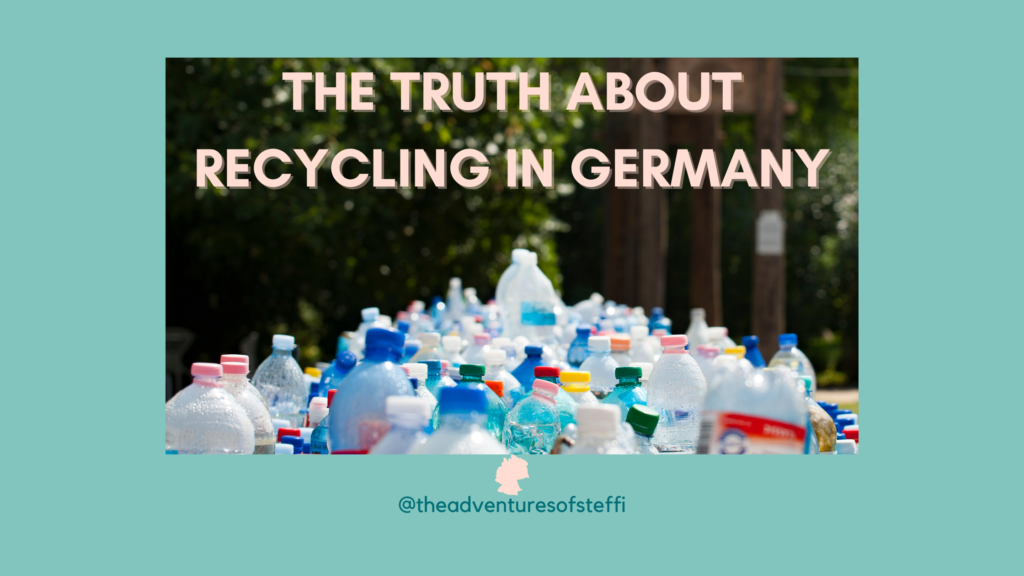Recap on Recycling in Germany
Have you read my first post on recycling in Germany? If not, I highly recommend you start there before reading on. I want you to have the full picture.
Don’t worry, I’ll wait…

Can’t be bothered? A bit lazy, but fair enough. Here’s a recap:
- Recycling in Germany is a national pastime.
- The separation of household waste and the Pfand system actually started in East Germany.
- There are several bins and you must read your local government website for what to put in them because there can be consequences otherwise.
- Yes, Wales has been doing it for years, but most countries haven’t so it is new and exciting for us. Shush with your smugness.
- According to the reports, Germany is a world leader in recycling.
I think that’s everything. Let’s go!
Instagram vs Reality
On the surface, the recycling initiatives in Germany look wunderbar. Certainly, as an Ausländerin who did not have any experience with this level of recycling in her previous life.
However, during my research, articles kept popping up over and over again, begging me to read them. So I did.
It turns out the reality of recycling in Germany is actually SODA-PRESSING.
*BA DUM DUM TSS*
Okay, serious stuff now.
Disclaimer – this issue is absolutely NOT exclusive to Germany. There are a number of other rich Western countries doing the exact same thing.
However, it was surprising to learn about Germany, given that they are held on such a high pedestal when it comes to recycling.
I mean, there are children’s books written about the different coloured bins for crying out loud.
And also – this is a blog about life in Germany so….
Let’s talk numbers.
In 2017, Germany produced 6.2 million tonnes of plastic waste.
A lot of that actually got burned in incinerators (also not totally fab for the environment…) and the rest was “recycled”.
By which, I mean one-third of it was exported.
And from the rest of it, just 7% ends up being reintroduced back in the plastic life cycle.
Until 2018, China was the world’s biggest plastic waste importer. They had the infrastructure to deal with it. And along with the US, UK and Japan, Germany was one of China’s biggest customers.
But in 2018, China essentially shut its doors to the import of waste with its Waste Import Ban.
Western countries then turned to other countries like Malaysia. This article states that between Jan and Oct 2018, Germany’s plastic waste that was exported to Malaysia increased by 125 per cent.
The rubbish started piling up and these smaller, less-prepared countries became overwhelmed with the sudden increase in imported plastic waste.
They couldn’t, and still can’t, keep up with the demand. They lack the facilities and environmental oversight.
Out of sight, out of mind.
As I was reading through these reports, one thing started to become pretty clear to me, as it has done to others.
Germany boasts fondly about its great recycling abilities but appears to leave its responsibility at the border. They even count exported waste as having already been “recycled”…
It’s like shoving something you don’t want to deal with to the back of the wardrobe and forgetting about it.
But why do they do it?
Money, Money, Money

Of course, das Geld plays a huge part in the decision to export so much waste. Welcome to capitalism!
The short answer here is that burning or recycling in Germany actually costs more money than exporting plastic to other countries.
An incinerator in Germany can cost anywhere between ca. €150 and €800 per ton. Sea freight for exporting plastic costs around €40 per ton and the statistics estimate the overall cost of exporting it to be €180 per ton.
Cheapest option wins.
Okay, so we now know that Germany is not quite as green as it once seemed, so…
Where do we go from here?
It’s not totally bad news. There are people that care.
Some German waste management companies have already stopped exporting and are fronting the costs to recycle or deal with plastic waste in another way.
Unfortunately, this does mean they are burning a lot more instead of actually recycling it. But, according to some rumours (and a quick Google), some incinerators are slowly becoming more environmentally friendly.
The second bit of good news is that some German discount supermarkets are already making more progress when it comes to recycling, particularly plastic recycling.
The Schwarz Group, which owns both Lidl and Kaufland has recently invested in two waste management companies. This gives them the opportunity to reprocess packaging themselves.
Apparently, the goal is to make its in-house brands recyclable to the MAXXX by 2025.
2021 also sees the introduction of the ban on single-use plastic.
The dream.
Of course, the dream is to move back to a circular economy.
But that’s still a long way off, especially given the huge rise in single-use plastic products since the start of Covid-Times.
Moving forward also relies heavily on consumer input – by ensuring that we are correctly sorting our packaging (not all food packaging can/should go in that yellow sack!) and by trying to use less plastic packaging.
In my opinion, and from my anecdotal experience, I believe German supermarkets promote far more plastic packaging than I was seeing back in England.
I often get odd looks from other customers and the cashier when I refuse to put my fruit and veggies into plastic bags. In fairness, I get odd looks from the Germans in general. This could all be totally wrong and feel free to correct me if I am wrong, but it’s what I’m seeing.
Hopefully, with the ever-looming threat of Climate Change, the future will find Germany and all the other rich countries taking their waste management responsibilities more seriously. Hopefully. We all have hope, don’t we?
